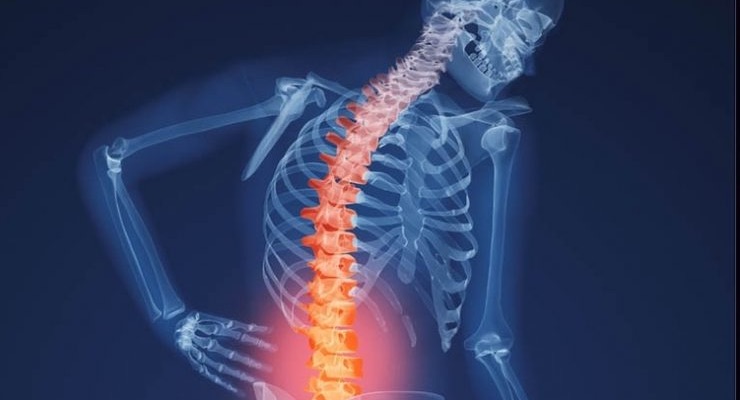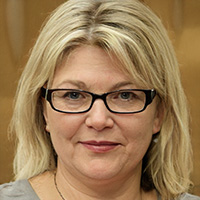Osteoporosis: symptoms, causes, and treatment. The most serious complication of this disease is the fractures which can occur. This can cause a great loss of autonomy in our elders.
In this entry we talk more in depth about this increasingly prevalent disease. We focus, among other aspects, on its symptoms, treatment and prevention.
What is osteoporosis?
Osteoporosis is a skeletal disease that occurs due to a decrease in bone density. This is a result of the loss of normal bone tissue.
Bone is a living tissue that is constantly being renewed. On the one hand new bone is formed (bone formation). On the other hand, aged bone is lost (bone resorption).
When the balance between the two processes is broken, either because the amount of new bone created decreases or because resorption increases, osteoporosis appears.
Because of the loss of bone density, bone with osteoporosis is more fragile, increasing the likelihood that it will be damaged or fractured.
Osteoporosis symptoms
Osteoporosis does not produce symptoms, so it neither hurts nor causes any alteration that would indicate that we suffer from it. Thus, it is a disease that does not show any signs until the loss of bone is so important that fractures appear. That is why this disease has been given the nickname of silent epidemic.
As osteoporosis progresses, the following symptoms are experienced
Progressive decrease in height.
Back bent forward (kyphosis).
Back pain, caused by a fractured or crushed vertebra
Fracture of a bone very easily and without apparent cause.
Osteoporosis causes
The metabolic changes that we have explained above depend on very diverse factors: aging, genetics, different hormones, diet, physical activity and toxic habits, among others.
The risk of suffering from osteoporosis will be determined by the maximum level of bone mass that is formed in adulthood and the decrease produced as a result of old age.
As for genetic and hereditary factors, children of mothers who suffer from osteoporosis are more likely to suffer from it, as they are born with a lower volume of bone mass.
Having said that, let us pay special attention to the first of the factors listed: aging.
Osteoporosis is a very common disease in older people due to different causes:
Menopause and andropause. In the case of women, menopause is one of the causes that most influences their development in women, since the disappearance of the ovarian function produces an increase in bone reabsorption. Similar effects are produced in men with the arrival of andropause.
Diseases that lead to a prolonged stay in bed.
Malnutrition and extreme thinness. Therefore, it is vital that our elders consume all the necessary daily nutrients.
Medication. Some drugs favor the decalcification of the bones.
Osteoporosis in the spine
It is, along with the wrists and hips, the location where osteoporotic fractures most frequently occur.
In the patient with osteoporosis, the back pain is usually almost persistent. This appears in the dorsal column or in the lumbar column, in most of occasions of sudden form, when making small efforts (like sitting down, coughing or laughing).
This ailment produces a progressive crushing of the spine that leads to the development of a stooped posture and a consequent loss of height. In some cases, up to 15 centimeters in comparison with the height of when the person was young.
The duration of this pain is variable, so that in some patients it can last a few weeks, while in others it can last up to two or three months.
Osteoporosis: symptoms, causes, and treatment: Types of Osteoporosis
There are three different types of osteoporosis:
Primary Osteoporosis
Linked to sex and age.
It is subdivided, in turn, into senile osteoporosis (appears in women and men over 70 years), idiopathic osteoporosis (appears in young people with no known cause) and postmenopausal osteoporosis (occurs in women between 51 and 75 years).
Secondary Osteoporosis
All cases of osteoporosis that are a consequence of other diseases, both the effects of these diseases and their treatment, are part of this type.
Others
The so-called “rare” osteoporosis is included here, since its prevalence is less common than the previous ones.
Within its low frequency, the most prominent is the osteoporosis associated with pregnancy and lactation.
Osteoporosis degrees
Through a radiological test, the doctor will observe the degree of bone mass density of the person, distinguishing between them:
Degree Definition
Normal Bone density is within the range of +1 and -1.
Low Bone Density Bone density is between -1 and -2.5.
Mild Osteoporosis: Bone density is below -2.5.
Severe: Bone density is below -2.5 and one or more fractures have already occurred because of it.
During the progression of the disease, the affected person suffers continuous fractures that greatly limit his or her normal daily activity.
When the degree of osteoporosis is already in an advanced stage, medical personnel can evaluate the permanent total disability in the work environment if the patient can no longer carry out professional functions that require some physical effort.
If the scenario is milder and the disease does not affect work performance, partial permanent disability can be assessed.
Osteoporosis is curable
We bring here a phrase as positive as it is motivating: osteoporosis has a cure.
About this, the specialists agree that it has a cure as long as it is maintained a regularity in its treatment. If, for example, for a week the patient does not follow the established medical guidelines and does not take the prescribed calcium, the blood continues to remove it from the bone.
Thus, if our elder loses that consistency, osteoporosis can continue to progress until a cure is no longer possible.
Osteoporosis treatment
The established treatment for the remission and cure of osteoporosis is based on the following pillars
Medications for Osteoporosis
The drugs are prescribed to reduce the risk of fractures, so their goal is to make the bones less likely to break.
The most widely used drugs to both prevent and treat this disease are bisphosphonates. These are usually taken for five years, at which time the doctor will re-evaluate the patient’s condition and determine whether to continue treatment or take a break from it.
On the other hand, the doctor may prescribe calcium and vitamin D supplements to fight decalcification and to promote the transport of calcium from the intestine to the bone.
Healthy living
The choice of treatment to follow is often based on an estimate of the risk of fracture of a bone in the next 10 years. If our major’s risk is not high, the treatment could be based on modifying life habits to avoid the progression of bone loss.
Preventing Osteoporosis
Just as important as the treatment itself is prevention. Through daily guidelines, we can minimize the loss of bone mass characteristic of adulthood.
To achieve this, there are two areas in which our elders must maintain a proper routine: diet and physical activity.
Osteoporosis: symptoms, causes, and treatment. Foods for osteoporosis
The diet to prevent osteoporosis should be rich in calcium and vitamin D. (That is why, if our elder does not ingest them through food, he should do it through pharmacological supplements).
Thus, these are the foods that cannot be missing from our elders’ diet:
Dairy: milk, yogurt, cheese, dairy ice cream…etc.
Fish: sardine, tuna, salmon, mackerel…etc.
Other proteins: lean meats and eggs
Beans and derivatives: white beans, pinto beans, chickpeas…etc.
Vitamin K: dark green leafy vegetables such as spinach, broccoli, Brussels sprouts…etc.
Osteoporosis: symptoms, causes, and treatment: Exercises for Osteoporosis
Physical activity is a very effective way to combat osteoporosis. With exercise, our senior will strengthen muscle mass, improve posture, relieve pain and ultimately reduce the risk of bone fractures.
The most recommended exercises are the following:
Resistance exercises: by lifting dumbbells or using your own body weight you will increase your muscle strength.
Balance exercises: their objective is to avoid falls (a point to be taken into account to avoid the worst consequences of the disease).
Postural exercises: the muscles of the back will be exercised, above all, to improve posture.







